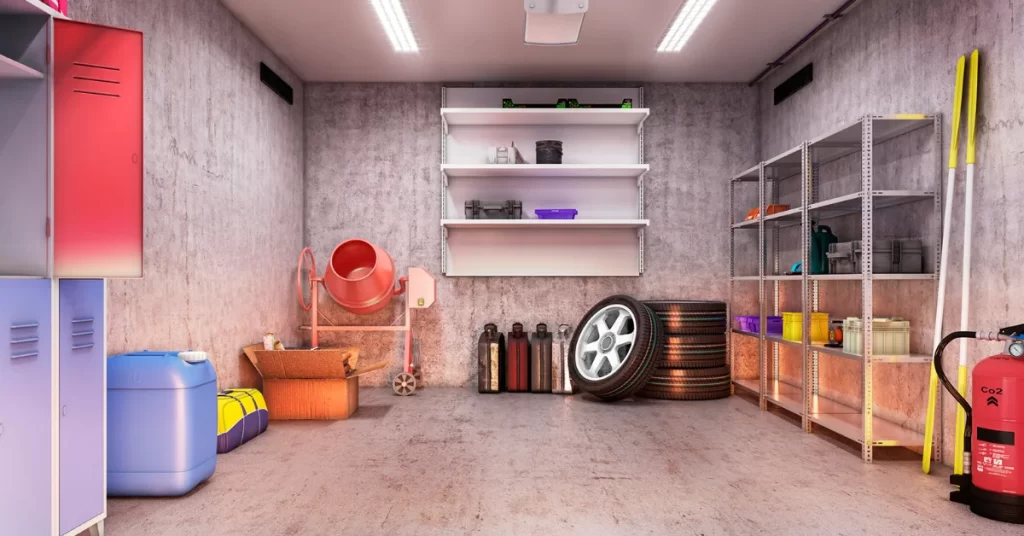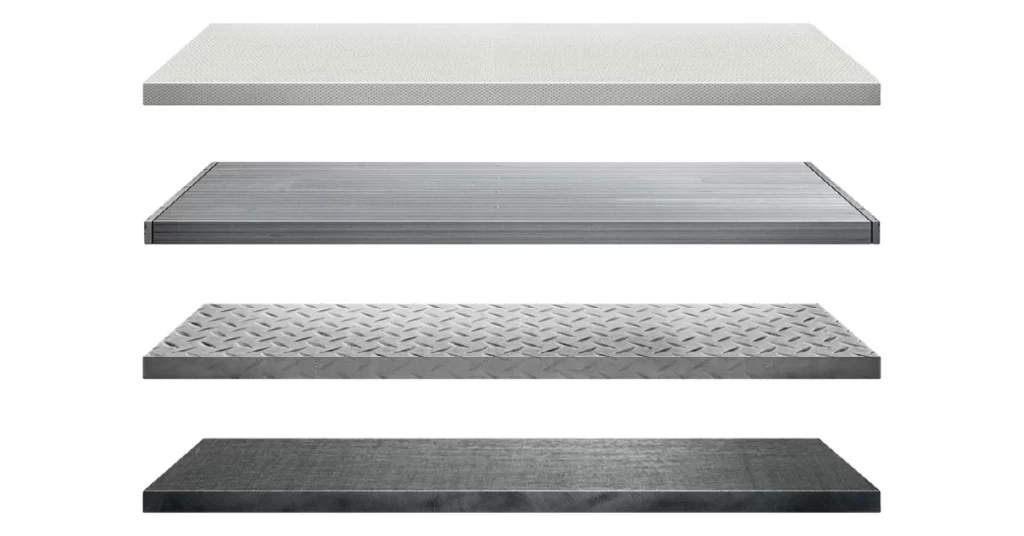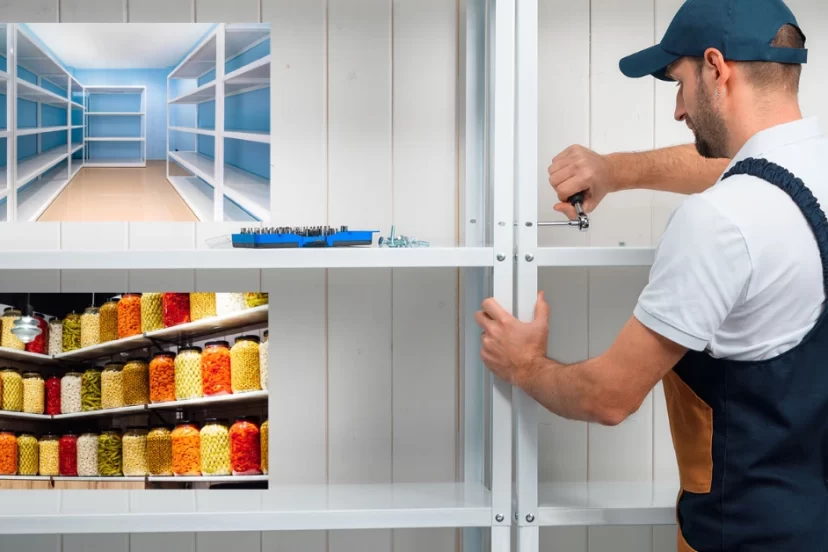Garage Shelving Buy or DIY
Garage shelving choices: having a well-organized and functional garage for maximizing storage space and creating a clutter-free environment. One of the key components of an organized garage is the proper selection and setup of shelving. In this article, I will guide you through the process of choosing the right shelving for your garage storage needs and provide helpful suggestions on how to set it up effectively.

Assessing Your Storage Needs
Before diving into the world of garage shelving, it’s crucial to assess your storage needs. Take some time to consider the types of items you need to store in your garage. Are you looking to organize tools, sports equipment, gardening supplies, or a combination of items? By identifying your specific storage requirements, you can make informed decisions about the shelving options that will best accommodate your belongings.
Evaluating Available Space
Once you have a clear understanding of your storage needs, it’s time to evaluate the available space in your garage. Measure the dimensions of the garage and identify potential storage areas such as walls, the ceiling, and the floor. Consider the layout and traffic flow in your garage to ensure that your shelving choice doesn’t obstruct movement or access to other items and areas.
Types of Garage Shelving
There are several types of garage shelving to choose from, depending on your preferences and the available space. Let’s explore some popular options:
- Freestanding Shelving Units: freestanding shelving choices are good for garages because they are versatile and easy to move around. They come in a variety of sizes and materials, such as plastic, metal, and wood. The downside is that they can take up valuable floor space and may not be as sturdy as other options.
- Wall-Mounted Shelving: Utilizing wall space is a great way to maximize storage in your garage. Wall-mounted shelving can be installed using brackets, tracks, or hooks. This option keeps the floor clear and provides easy access to your items. It’s also more stable than freestanding shelving.
- Overhead Storage Solutions: Overhead storage is perfect for those who have limited floor space. It’s typically installed above the garage door or in the ceiling rafters. This type of shelving is ideal for storing seasonal items, such as holiday decorations or winter sports equipment. However, it can be difficult to access and may not be suitable for heavy items.
Choosing the Right Shelving

When selecting the right shelving for your garage, there are a few key factors to consider:
- Weight Capacity: There are two main types of shelving to consider: light-duty and heavy-duty. Light-duty shelving is typically made of plastic or lightweight metal and can hold up to 250 pounds per shelf. Heavy-duty shelving, on the other hand, is made of heavier materials like steel and can hold up to 1,000 pounds per shelf or more.
If you plan to store heavier items like power tools or car parts, then heavy-duty shelving is the way to go. However, if you only plan to store lightweight items like seasonal decorations or gardening supplies, then light-duty shelving may be sufficient. - Shelf Size and Adjustability: Consider the dimensions of the items you need to store and ensure that the shelves are wide and deep enough to accommodate them. Adjustable shelving choices can be beneficial as it allows for flexibility in organizing items of various sizes and allows you to rearrange them when there are storage changes in the future.
- Durability and Material Quality: Opt for shelving choices made of sturdy materials such as steel or heavy-duty plastic. Ensure that the shelving is designed to withstand the weight of your items and has a long lifespan.

Installation and Setup
Once you have selected the appropriate shelving, it’s time to install and set it up in your garage. Follow these steps for a successful installation:
- Prepare the Garage Space: Clear out any clutter and organize your items to create a clean and spacious area for the shelving. If needed, clean, paint and repair the garage walls or ceiling before installation. You may have to mark the location of the wall studs using a stud finder. Marking studs from top to bottom saves time when attaching multiple items to a wall.
- Follow Manufacturer Instructions: Carefully read and follow the manufacturer’s instructions for assembling and installing the shelving. Pay close attention to anchoring requirements and ensure that the shelves are properly secured into the wall studs for stability and safety.
- Utilize Additional Storage Accessories: Enhance the functionality of your shelving system by incorporating additional storage accessories. Hooks, bins, and baskets can be added to the shelves to keep smaller items organized and easily accessible. You can also integrate cabinets or tool racks into your shelving system to further optimize your storage space and create a more efficient organization system.
- Tools to have on hand may include:
- Electric miter saw or circular saw (custom shelves or to make them fit in a tight space)
- Drill
- Drill bits and drivers, set
- Laser level or bubble level
- Stud finder
- Tape measure
- Hand saw
- Chalk snap line
- Pencil
Organizing and Maintaining the Shelving System
Once your shelving is installed, it’s time to organize your items effectively and maintain the system for long-term usability. Consider the following tips:
- Categorize Items and Create Zones: Group similar items together and designate specific shelves or sections for different categories. This will make it easier to find what you need and maintain an organized garage.
- Implement Labeling and Inventory Systems: Label shelves and storage containers to quickly identify the contents. You can use labels, markers, or color-coded tags to make the organization system more intuitive. Additionally, keeping an inventory of stored items can help you keep track of what you have and prevent duplicate purchases.
- Regular Maintenance and Adjustment: Periodically reassess your storage needs and make adjustments to your shelving configuration as required. As your storage needs change over time, adapt the shelving system accordingly to optimize its efficiency.
Conclusion
By assessing your storage needs, evaluating available space, selecting the appropriate shelving, and properly setting it up, you can create a well-organized and functional garage. Remember to consider factors such as weight capacity, shelf size, and material quality to ensure durability and safety.
If you find it challenging to meet the structural demands of the garage shelves, consider reaching out to a skilled carpenter or contractor. Their expertise ensures the construction of robust and securely positioned shelves, encompassing a range of shelving alternatives.
Check out Shelves vs Cabinets-Pros and Cons
FAQs
- How much weight can garage shelving typically hold?
- Garage shelving weight capacities vary depending on the specific product. It’s essential to check the manufacturer’s specifications for the recommended weight limits.
- Garage shelving weight capacities vary depending on the specific product. It’s essential to check the manufacturer’s specifications for the recommended weight limits.
- Can I install garage shelving on my own, or do I need professional assistance?
- Many garage shelving systems are designed for easy installation and can be assembled by homeowners. However, if you are unsure or have complex requirements, it’s recommended to seek professional assistance.
- Many garage shelving systems are designed for easy installation and can be assembled by homeowners. However, if you are unsure or have complex requirements, it’s recommended to seek professional assistance.
- What are some alternatives to traditional shelving for garage storage?
- In addition to shelving, you can explore other storage choices such as wall-mounted hooks, pegboards, magnetic strips, cabinets and ceiling-mounted racks to maximize your garage storage options.
- In addition to shelving, you can explore other storage choices such as wall-mounted hooks, pegboards, magnetic strips, cabinets and ceiling-mounted racks to maximize your garage storage options.
- How do I prevent items from falling off the shelves in the garage?
- To prevent items from falling off shelves, consider using shelf liners, baskets, or storage bins. These accessories help keep smaller items secure and organized.
- To prevent items from falling off shelves, consider using shelf liners, baskets, or storage bins. These accessories help keep smaller items secure and organized.
- Are there any safety considerations to keep in mind when setting up garage shelving?
- Yes, it’s important to ensure that the shelving is properly anchored and stable. Follow the manufacturer’s instructions for installation and avoid overloading the shelves beyond their recommended weight capacities. Regularly inspect the shelving system for any signs of damage or wear.
- Yes, it’s important to ensure that the shelving is properly anchored and stable. Follow the manufacturer’s instructions for installation and avoid overloading the shelves beyond their recommended weight capacities. Regularly inspect the shelving system for any signs of damage or wear.
- What is the best way to organize my garage using shelving?
- Start by grouping items by category, such as tools, sports equipment, and gardening supplies. Then, designate specific shelves or areas for each category, and label them clearly to make it easy to find what you need.
- Start by grouping items by category, such as tools, sports equipment, and gardening supplies. Then, designate specific shelves or areas for each category, and label them clearly to make it easy to find what you need.




